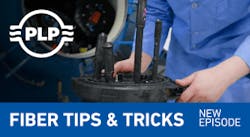I post my cell number and email address at the end of every column, and over the years, I, or others working for me, have trained at least a thousand technicians. Based upon our experience and you faithful readers, we’ve received hundreds of calls asking for help finding solutions to many unresolved case of trouble. Usually these cases have been looked at by a few technicians and other experts before we hear from folks, so when we get the call for help, it means it’s usually a tough case.
While we often — even usually — are successful in helping uncover the cause of the trouble, we aren’t right all the time. Following are some cases where we got it wrong. I could slide these under the rug, so to speak, but we can all learn from these opportunities. I know that I certainly do!
Here are some examples of not hitting the nail on the head.
Example #1
Donald,
We have a bandwidth problem on a 200-pair filled cable leaving our central office. When testing any cable pair there is no physical trouble and all pairs show acceptable longitudinal balance. Power influence is acceptable on all pairs less than 80dBrnC. Circuit noise is also acceptable less than 20dBrnC. Here is where things get strange. The power company recently installed a new lead along our cable route. They also installed a capacitor bank on the route. When connecting a technician’s butt set across any pair that pair is quiet when either the on hook or the off hook is selected. But when the tone probe is used there is audible "motor boating" on any pair. What do you think is happening?
Robert
My response was:
I definitely do not know what the root cause is, but I think that the offending frequency is somewhere below 800Hz or above 2500Hz but in the voice grade range. When using a POTS circuit, we talk on the frequencies from 800Hz to 2500HZ. Unwanted interfering tones above 800Hz and below 2500Hz are filtered out with a C message filter. Your tone probe does not have a C message filter. I believe that is why the tone probe picks up the "motor boating" and the butt set does not pick it up. I think that the capacitor bank is your problem and not a bonding and grounding issue. I suggest that you contact the power company and have them take the capacitor bank off line and you can retest to see if the trouble goes away.
Donald
Robert called back and stated that he found the problem. He stated that he found a loose bullet bond in the CO vault that was arcing. When he tightened the bullet bond the arcing ceased and the noise went away. Go figure.
Example #2
Hi, Don,
It has been a long time since I have bothered you. A technical issue has come up when we cross-connect a POTS line to a cable with no end point plugged into the jack, we get a hum on the pair. What do you think is happening?
Frank
My response was:
That vacant cable pair is open on one side on a lateral (bridged tap), open one side beyond your terminal, or crossed with a non-working conductor. Keep me in the loop.
Donald
Frank’s reply was:
Don,
Digging deeper, we found that the hum on the FAX was from the FAX machine itself. Or more correctly the electrical outlet it is plugged into had 40 volts on the neutral.
InvisiLight® Solution for Deploying Fiber
April 2, 2022Go to Market Faster. Speed up Network Deployment
April 2, 2022Episode 10: Fiber Optic Closure Specs Explained…
April 1, 2022Food for Thought from Our 2022 ICT Visionaries
April 1, 2022Example #3
Here’s a case of getting it right until I didn’t!
We were working with an independent Telco in solving a problem they had where customers were complaining of snapping on the line. In every instance, the vacant POTS line tested OK. I finally proved the faults were due to corrosion at the cross-connect box on 25 pair modules that tested OK until high voltage caused the gas-filled modules at the customer’s network interface to fire causing audible snapping on the line.
And here’s where it didn’t work:
Shortly after successfully resolving the case above, a reader called describing snapping on the line when the POTS circuit tested OK and I thought "I got this," and told the reader that corrosion on modules at the cross-connect box was causing the snapping.
The reader called back and stated that that wasn’t the answer and that the root cause was a bad DSL/POTS card. He said that he wanted to let me know that he finally got to the bottom of this circuit and in the process developed this tip for testing for snapping on the line.
Reader Process for Testing for Snapping on the Line
- There is a cord that plugs into the LIU card. The other side of the cord is a 15-pin connector. (I found the cord in the CO. The toll test man had no idea what it was for!) The cord takes the signal from the LIU and leaves the power so the span is still powered.
- The 15-pin connector plugs into a jack panel located in the power plant of the remote terminal. There are 6 bantam jacks labeled term, line, and monitor, for both side 1 and side 2.
- If you take a bantam cord and plug it into term side 1 and 2 you have now looped your T-1 circuit. You can then go to a repeater and pop the card, put in a test card and with bantam cords access your circuit and look for the loop.
- Most of the old SLC96 systems around me are either fed by fiber now or, if copper fed, abandoned. They will never fiber up this one, so someone has to know how to work on it!
Anyway, even though you couldn’t help me with this one, your columns are a big help to me at work so thanks and keep up the good work.
I got the first customer’s problem right and found the root cause, but assuming that the other reader had the same problem caused me to mis-analyze and miss the second caller’s problem. Who knew?
Signing off
Thank you, loyal readers. I hope you find our mistakes to be helpful as you face the toughest problem at your company: keeping customers happy and preventing them from jumping to the competition. Please share your concerns, questions, and challenges, with us so we can focus on issues that affect you.
We won’t use your name, company name, or any identifying information, without proper written approval.
Contact me at 831-818-3930 or [email protected].
Like this Article?
Subscribe to ISE magazine and start receiving your FREE monthly copy today!
About the Author





